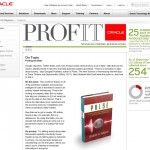by Douglas Hubbard | Feb 2, 2012 | Articles, News, Pulse: the New Science Blogs
Oracle, PROFIT, 2012
“Google searches, Twitter feeds, and even Amazon sales ranks produce a lot of data—data that can be used to identify trends in real time and help business leaders get ahead. ‘There’s a revolution in data about society,’ says Douglas Hubbard, author of Pulse: The New Science of Harnessing Internet Buzz to Track Threats and Opportunities (Wiley, 2011). Here Hubbard tells Profit what the pulse is—and how to find it.” [view article]
by Douglas Hubbard | Jul 23, 2011 | News, Pulse: the New Science Blogs
“Information from the Pulse will become part of models that are dynamically simulating and forecasting businesses and the consequences of management decisions … it will have at least the following four types of impact:”
- “Decisions based on responses to macro-trends will be faster. We won’t have to wait weeks—and certainly not 15 months as in the NBER report on the end of the recession—for indications of changes in fundamental economic factors, health conditions, and public opinions.”
- “In some cases, the Pulse will be more accurate than traditional methods of collecting data about major trends. While the traditional methods like polls will continue to be used to calibrate and validate the Pulse, the Pulse will avoid some problems that plague traditional surveys.”
- “Trends that otherwise would not have been seen at all will be visible. Traditional surveys have to be purpose-built. In other words, we have to have an idea of what we are looking for in advance, and then we have to collect that specific data. The Pulse offers a way to see trends that no one even knew to look for when the data was generated.”
- “Basic models of society will change. Our ability to investigate and respond to the environment more quickly and accurately has implications for organizational structure, logistics, finance, and virtually every other part of business, government, and the study of humanity. This may be the greatest impact of the Pulse.”
– Hubbard, Douglas W. (2011). Pulse: The New Science of Harnessing Internet Buzz to Track Threats and Opportunities (Kindle Locations 439-453). Wiley. Kindle Edition.
by Douglas Hubbard | Apr 19, 2011 | General Topics, News, Pulse: the New Science Blogs
Amazon just sent out its email blast for my next book Pulse: The New Science of Harnessing Internet Buzz to Track Threats and Opportunities. If you get those, you know what I mean (e.g., “If you like book X you will like this new book” etc.). With my previous books, this is usually the beginning of when sales really start to pick up for a new book release. We’ll see.
by Douglas Hubbard | Apr 14, 2011 | General Topics, News, Pulse: the New Science Blogs
My new book, Pulse: The New Science of Harnessing Internet Buzz to Track Threats and Opportunities, just came in the mail. Amazon says it is available now and it should be on bookstore shelves in a day or two.
This book seems to generate the most excitement of all of my books so far. When I explain the idea of using Internet data mining to forecast major economic and social trends, people at the seminars where I speak are universally intrigued. Sam Savage, author of The Flaw of Averages, told me “This may be your biggest book yet”. That seemed to be bolstered by the fact that Publisher’s Weekly put Pulse in its “PW’s Top 10: Business & Economics” for the spring of 2011. So I’m cautiously optimistic.
The book is coming out earlier than the originally planned release, so we are all rushing to make sure the accompanying site is up soon. It will have a lot of interesting functionality, so be sure to check it out sometime after April 21st.
Doug Hubbard
by Douglas Hubbard | Jan 19, 2011 | General Topics, News, Pulse: the New Science Blogs
My next book – Pulse: The New Science of Harnessing Internet Buzz to Track Threats and Opportunities – is on track to come out in April. We are just going the edit process for the manuscript.
This book is an expansion on a concept I mentioned in How to Measure Anything. I write about how sources of massive amounts of data on the internet can be used to track and forecast major trends. Recent research shows how an analysis of millions of Tweets or Twitter can be used to forecast movie box office receipts or political opinions. Google Trends data about the frequency of search terms can be used to track unemployment levels and flu outbreaks. It is a vast new measurement instrument that is mostly untapped.
My publisher and the experts I asked to review the manuscript are excited about this book. I’ll keep you posted.
Doug Hubbard


